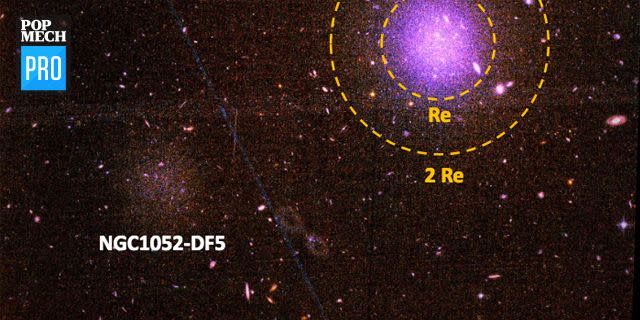Scientists Are Arguing About Dark Matter Again

Last year, astronomers thought they had discovered a bizarre new galaxy that threatened to challenge the basic principles of physics. Turns out not so much.
Now, the galaxy that scientists believed to contain no dark matter is looking much more normal. Scientists believe the whole thing was a miscalculation.
The questions first popped up in 2018 when scientists announced the discovery of a galaxy known as NGC1052-DF2 (DF2 for short).
"We thought that every galaxy had dark matter and that dark matter is how a galaxy begins," said Pieter van Dokkum of Yale University in New Haven, Connecticut, lead researcher of the Hubble observations, in a NASA press statement at the time.
"This invisible, mysterious substance is the most dominant aspect of any galaxy," van Dokkum said. "So finding a galaxy without it is unexpected. It challenges the standard ideas of how we think galaxies work, and it shows that dark matter is real: It has its own separate existence apart from other components of galaxies. This result also suggests that there may be more than one way to form a galaxy."
There was a lot about DF2 that puzzled scientists. Studies in recent years have estimated that dark matter makes up 27 percent of the universe, which would make it 85 percent of all matter.
So what is dark matter, exactly? Well, it's a bit complicated.
"We are much more certain what dark matter is not than we are what it is," NASA says. Dark matter, and its accompanying dark energy, is meant to explain the accelerated expansion of the universe. There are theories, like WIMPS (Weakly Interacting Massive Particles) or MACHOs (massive compact halo objects), but they remain just that.
But scientists at least feel confident enough to say that dark matter is a.) dark and b.) the stuff that makes up most of the universe. To have a galaxy without dark matter, then, would challenge a baseline understanding of the universe.
Scientists had missed DF2 because it only appeared to contain 1/200th the number of stars of the Milky Way. So when results came back showing that the galaxy had only 1/400th the amount of dark matter that scientists had predicted, DF2 became a puzzle 64 million light years away.
Then, in 2019, a second galaxy showed up with similar traits. Known as NGC 1052-DF4 (DF4), it seemed to confirm the DF2 findings: “Discovering a second galaxy with very little to no dark matter is just as exciting as the initial discovery of DF2,” van Dokkum said in a press statement.
Now, both claims are facing scrutiny from other scientists.
The first, DF2, was examined by astrophysicists Ignacio Trujillo, Matteo Monelli, and others from the Instituto de Astrofísica de Canarias (IAC), based in Spain. Using data from the Hubble Space Telescope, the Gemini Observatory, and three other sources, Trujillo's team believes that the initial estimates for DF2 "overestimated the distance of the galaxy." Instead of being 64 million light-years away, a distance known as 20 megaparsecs, it was only 42 million light-years, or 13 megaparsecs, away from Earth.
"For a long time, this has been (and continues to be) one of the most difficult tasks in Astronomy," Trujilo wrote in an accompanying blog post. "How to measure the distance to objects we cannot touch."
The distance of DF2 determines how scientists see the galaxy, which in turn determines how they estimate its mass. If it's only 13 megaparsecs away, then DF2 would only be "around a half of the mass estimated previously," the IAC states in a press statement, while "the mass of its stars is only about quarter of the previously estimated mass."
If DF2 has a much smaller mass than previously thought, Trujilo says, then it "implies that a significant part of the total mass must be made up of dark matter."
And now, Trujilo has his eyes set on DF4. Having applied their DF2 tactics to DF4, his team has published a paper on the pre-print server arXiv showing that the second galaxy is just 14.2 megaparsecs aways, as opposed to the 20 megaparsecs away that the Yale team had initially thought.
Speaking to ScienceAlert, Trujilo said he believes the distance measurement calibration methods used at Yale were "based on very massive galaxies" and are accurate when it comes to galaxies like DF2 and DF4. Popular Mechanics has reached out to van Dokkum for comment.
More data about DF4 from the Hubble Space Telescope will be available in the coming months, allowing both sides to analyze the far-off dispute even further.
The study of galaxies is a complex and tough subject. Earlier this year, the Hubble found a new galaxy entirely by accident.
Source: ScienceAlert
('You Might Also Like',)
